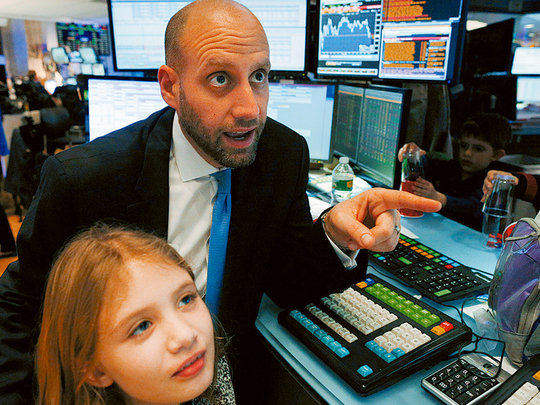
New York: The year’s strongest week for US equities was followed by one of its quietest, with energy stocks underpinning microscopic gains in a holiday-shortened week.
Stocks moved the smallest amount since July as the Thanksgiving holiday damped trading following the previous week’s 3.3 per cent surge in the Standard & Poor’s 500 Index. Mixed economic results and geopolitical unrest did little to sway equities ahead of next week’s jobs report and a Federal Reserve meeting scheduled to conclude on Dec. 16.
The S&P 500 rose 0.04 per cent in the 3 1/2 days to 2,090.11, its eighth gain in nine weeks. The gauge closed 1.9 per cent below its May peak and, with one day left in November, is up 0.5 per cent for the month after rallying 8.3 per cent in October. The Russell 2000 Index surged 2.3 per cent for the week to close at its highest level since Aug. 19.
Volume was light as investors honed their focus on the future of monetary policy in the US, said David Donabedian, chief investment officer of Atlantic Trust Private Wealth Management, which oversees $27 billion. “The market continues to come to peace with the idea that the Fed will do its first increase in mid-December.”
Compared with where they were leading up to the last Fed meeting in October, equities are in a much improved state. At the start of that month, the S&P 500 was still down 8.6 per cent from its August high, while the Chicago Board Options Exchange Volatility Index was at 22.55. Three weeks ahead of the forthcoming meeting, shares in the benchmark gauge are back in the range they were trading weeks before the correction started and the VIX has retreated back to 15.12, just above its pre- sell-off average of 14.9.
Still, it’s not like investors have made up their minds about the future. The S&P 500 has alternated gains and losses over the last nine straight sessions, the longest such streak since 2013.
Companies with a heavier domestic revenue stream are the likeliest to do well amid economic reports that show positive US growth — or at the very least, “numbers that aren’t near as bad,” said Tom Stringfellow, president and chief investment officer of San Antonio-based Frost Investment Advisors LLC, which manages about $11 billion. “What’s really getting a bid right now are those companies that are less impacted by dollar strength overseas.”
Economic reports showed mixed results. Orders for US business equipment climbed more than forecast in October, indicating steady domestic demand is encouraging corporate investment even as global sales waver. Meanwhile, consumers are benefiting from accelerating income gains, though that didn’t translate to higher household spending or confidence measures.
The week’s economic data didn’t change the course of a potential rate hike and “the market’s waiting for what the Fed’s actually going to do,” said Bob Baur, chief global economist at Principal Global Investors in Des Moines, Iowa. The firm oversees $333 billion. It’s also taking a breather because October’s “huge rebound might’ve been a little too much, too fast,” he said.
The probability of a boost to interest rates in next month’s meeting is 72 per cent, according to fed fund futures. Amid more certainty about the timing, “the only thing that might change it is if we have a hugely discouraging jobs report,” Baur said. And even that doesn’t seem very likely given the decline in initial unemployment claims.
Similarly, the market was unfazed by renewed concerns about geopolitical tensions after a Russian warplane was downed by Turkish forces. Meanwhile, Pfizer Inc.’s $160 billion megadeal with Allergan Plc was met by a cool reception. Allergan rose 2.3 per cent on the week while Pfizer increased 1.9 per cent.
Higher oil prices helped to spur a 1.3 per cent gain for energy stocks, capping a second consecutive week of gains. Meanwhile, consumer-staples stocks rose each day of trading to close at the highest level in more than three weeks. Utility stocks, the week’s biggest laggard, fell 1.6 per cent.
A volatility measure fell for a second consecutive week. The Chicago Board Options Exchange Volatility Index has tumbled more than 60 per cent after spiking to the highest in almost four years during the S&P 500’s summer swoon. Investors may need to brace for higher volatility ahead of the Fed’s meeting.
“We still will see volatility, particularly because there’s a lot of lead-up to the Fed meeting,” said Tom Anderson, who helps oversee about $8 billion as chief investment officer at Boston Private Wealth. “We’ll likely have choppiness over the coming weeks.”










